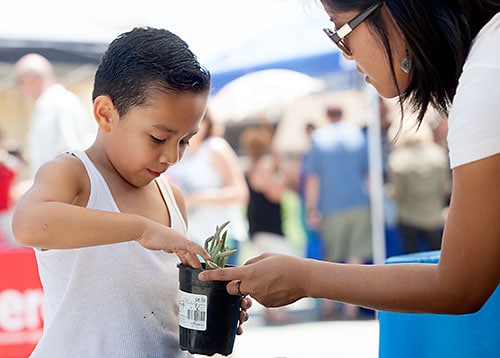Expo offers a torrent of green ideas

Governor Jerry Brown’s declaration of a state of emergency, and his subsequent mandate that cities reduce water-use statewide, has inspired many a Claremonter to rethink how their garden grows.
The strong level of motivation was evident in the healthy turnout at a Low-Water Expo held Sunday at the Rancho Santa Ana Botanic Garden. The free event, which ran from 11 a.m. to 3 p.m., was organized by members of Sustainable Claremont’s DRIP (Drought Resistance Irrigation Program).
DRIP, according to the Sustainable Claremont website, promotes “attractive, climate-appropriate landscapes in Claremont,” encourages the use of efficient irrigation, water conservation and water reclamation and provides resources to help local property owners achieve those aims.
The city of Claremont threw its support behind the expo, as did the Garden, which provided space for the ex
The expo fell on a dry and scorching hot day, underlining the climactic state of affairs that prompted the event. Still, community members showed up in droves, taking in 10-minute presentations by experts and browsing booths with information for residents looking to switch out their thirsty lawns and plants for water-wise options.
People manning booths included representatives of Sustainable Claremont—which has dozens of members and an estimated 1,000 people on its mailing list—and Sustainable Claremont sub-groups DRIP and CHERP (Claremont Home Energy Retrofit Program). Golden State Water, Southern California Edison and the Chino Basin Water Conservation District were on hand, as were the proprietors of
local companies specializing in drought-tolerant landscaping.
The Grow Native Plant Nursery at the Rancho Santa Ana Botanic Garden offered expertise and plants for sale. There was live music, and Nuños Bistro and Bar sold food and beverages. In a nod to the families in attendance, kids were invited to pot their own succulent to take home.
The focus of DRIP, event coordinator Sheila McCarthy explained, is educating the public about efficient water use. Members of DRIP have been focusing on getting materials up on the web, such as a step-by-step guide on undertaking a sprinkler to drip-system retrofit.
However, since Claremonters were asked to reduce their water use by 32 percent in April—12 percent more than neighboring cities like Pomona—it’s become evident DRIP needs to do more.
“People are ripping out their lawns without knowing what to do. We realized people are desperate for information, so we whipped this expo together in two months,” she said. “This is the time to strike. We’re hoping to do this a couple times a year.”
Claremont’s mandatory reduction may sound steep but it’s “totally doable,” according to Richard Haskell, a Harvey Mudd physics professor who serves as chair of Sustainable Claremont’s Water Action Group.
“Frankly, it’s been a no-brainer for a long time,” Mr. Haskell said. “Commercial and residential water use is about two-thirds landscaping, so certainly by re-landscaping we can make a big reduction.”
When you remove turf from your property and utilize drought-tolerant plants, you reduce water use by a factor of four or five, according to Mr. Haskell. “Suddenly, you realize, Oh, my gosh! We can do 32 percent.”
Anthony Perez was one of the employees manning the Grow Native Nursery booth, which was stocked with flowering plants and specimens like woodland strawberries as well as shrubs and succulents.
“Every day, we get people asking for recommendations on plants,” he said. “Even though they’re forced to look at gardening in a new way, they’re really excited to learn about a whole different world of flowers and plants. It doesn’t have to be all gravel and cactus.”
And many people at the expo were ready to help guide residents towards greener lives. This included the Claremont Environmental Design Group (CEDG), which is the company behind the Packing House renovation and Uncommon Good’s Whole Earth Building, which serves as a storefront as well as a beacon of energy-efficient design.
Located on a portion of the Claremont United Methodist Church campus, the structure features tunnels providing earth-cooled air, thick walls using on-site soil, solar power and a light/shade orientation meant to keep temperatures warm in the winter and cool in the summer.
Business has picked up significantly in recent months, according to CEDG landscape designer Lee Krusa.
“We’ve definitely been inundated with calls. With rebates on lawn conversation, the drought has opened opportunities where they weren’t before,” he said. “There’s a greater awareness now among people. There’s a level of openness to the idea of ingenuity that wasn’t there a few years ago.”
—Sarah Torribio
storribio@claremont-courier.com









0 Comments